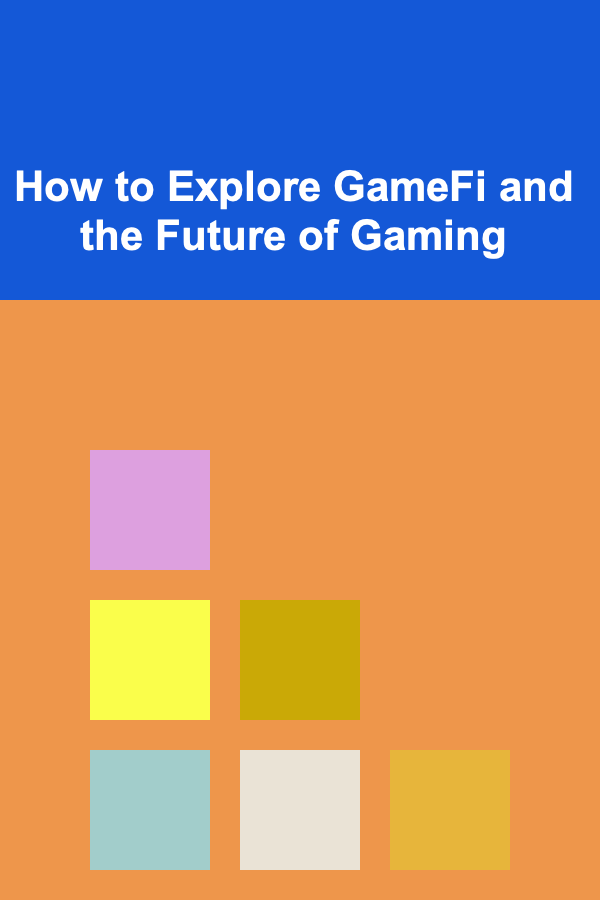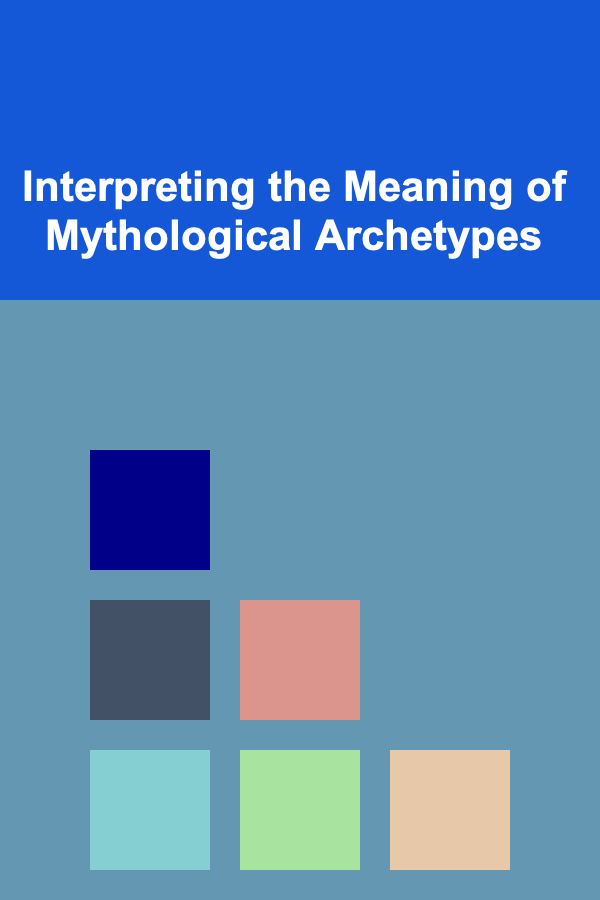
How to Explore GameFi and the Future of Gaming
ebook include PDF & Audio bundle (Micro Guide)
$12.99$5.99
Limited Time Offer! Order within the next:

The world of gaming has undergone significant changes over the years, from simple pixelated graphics to hyper-realistic 3D environments. As technology has advanced, so too have the possibilities for what gaming can offer. Now, there is a new frontier that is rapidly emerging: GameFi. This innovative concept combines gaming with decentralized finance (DeFi) principles to create new opportunities for both players and developers alike. But what is GameFi? And how does it tie into the future of gaming?
In this article, we will explore GameFi, how it works, and its potential to shape the future of the gaming industry. We will also look at the key elements of GameFi, including blockchain, NFTs (non-fungible tokens), play-to-earn mechanics, and decentralized economies, and analyze how these elements are changing the way we think about gaming. We will also address the challenges and opportunities GameFi presents and speculate on what the future of gaming might look like in this new era.
What is GameFi?
GameFi is a portmanteau of "game" and "finance" and represents a new paradigm in the world of gaming. It involves the integration of decentralized finance (DeFi) systems into video games, allowing players to earn real-world financial rewards through in-game activities. This can range from owning virtual assets, trading items, earning cryptocurrency, to participating in decentralized governance systems.
Unlike traditional games, where players spend money to buy in-game items or cosmetics without any real-world value, GameFi leverages blockchain technology to create assets that can be bought, sold, and traded on secondary markets. This gives players the potential to earn a tangible financial reward from their time spent gaming.
Key Elements of GameFi
1. Blockchain Technology
At the core of GameFi is blockchain technology. Blockchain is a decentralized, distributed ledger that allows for the creation of secure, transparent, and tamper-proof records. In the context of GameFi, blockchain enables the creation of unique in-game assets (e.g., weapons, skins, characters, land) that are owned by players. These assets are typically represented as NFTs, which are unique digital tokens that can be traded or sold on various marketplaces.
Because blockchain is decentralized, players have true ownership over their assets, meaning they can buy, sell, or trade items freely without relying on the game's developers or a central authority. This opens up a new world of possibilities for both players and developers.
2. NFTs (Non-Fungible Tokens)
NFTs are a fundamental part of GameFi. Unlike cryptocurrencies, such as Bitcoin or Ethereum, which are interchangeable with each other, NFTs are unique. They represent a specific asset, such as a rare item, a piece of land, or even a collectible character in a game. Each NFT is linked to a smart contract on the blockchain, ensuring its authenticity, scarcity, and ownership.
In GameFi, NFTs can represent anything from in-game items like skins, weapons, or characters, to entire virtual worlds. This enables players to truly own their digital assets, providing them with the ability to sell or trade these items in a way that was not possible in traditional games. As a result, rare items and collectibles have become valuable commodities in GameFi economies.
3. Play-to-Earn (P2E) Mechanism
The Play-to-Earn (P2E) model is perhaps the most revolutionary aspect of GameFi. Traditionally, video games operated under a "pay-to-play" or "pay-to-win" model, where players would spend money to enhance their gaming experience or progress faster. In GameFi, the model is reversed --- players can earn rewards by playing the game.
In a typical P2E game, players earn cryptocurrency or NFTs by completing tasks, defeating enemies, or achieving specific milestones in the game. These rewards can then be traded or sold on secondary markets, allowing players to convert their in-game earnings into real-world value. In some cases, players can even create and sell in-game assets or resources, which can be a lucrative venture for skilled players.
4. Decentralized Economies
A decentralized economy in GameFi allows players to participate in the creation, governance, and maintenance of in-game assets and currencies. Unlike traditional gaming companies that control the in-game economy and make decisions on behalf of players, GameFi projects often implement decentralized governance systems that allow players to vote on key decisions, such as game updates, rules, and financial matters.
This decentralization ensures that the in-game economy is more transparent and player-driven. In some cases, players can stake tokens or participate in liquidity pools to earn rewards and even influence the direction of the game.
How GameFi Works
To better understand how GameFi operates, let's break down the mechanics of a typical GameFi ecosystem:
- Ownership of In-Game Assets: In a traditional game, players may purchase in-game items using real money, but they do not truly own these items. GameFi changes this by allowing players to own their in-game assets through blockchain-based NFTs. This means that the player holds the rights to these assets, and they can be traded or sold outside of the game.
- Rewards for Gameplay: In many GameFi projects, players are rewarded with cryptocurrency or NFTs for their in-game activities. These rewards are stored on the blockchain, making them transferable and tradable. The more players engage in the game, the more they can earn, making it a genuine play-to-earn experience.
- Secondary Markets: One of the key features of GameFi is the existence of secondary markets, where players can buy, sell, and trade NFTs and other in-game assets. These markets are often decentralized and powered by blockchain technology, allowing players to exchange their assets with others freely. Players can sell rare items, land, or even characters to others who are willing to pay in cryptocurrency.
- Community Involvement: Many GameFi projects incorporate decentralized governance, which means that players can participate in decision-making processes, such as proposing updates or changes to the game. This increases the sense of ownership and involvement for the player base and allows for more community-driven development.
The Impact of GameFi on the Future of Gaming
1. Empowering Players with Ownership
GameFi represents a fundamental shift in the way players interact with video games. Instead of simply spending money to buy in-game items that have no real-world value, players now have true ownership over their assets. This empowers players to monetize their gaming experiences, creating a new economy that rewards time, effort, and skill.
For example, players who invest time in acquiring rare NFTs or building virtual assets in a game can sell these items for real-world profits. This has the potential to create a new class of professional gamers and content creators who can sustain themselves financially through their gaming activities.
2. Unlocking New Opportunities for Developers
GameFi also opens up new revenue streams for game developers. By integrating blockchain technology and NFTs into their games, developers can create new ways to monetize their projects. They can sell NFTs, charge fees on secondary market transactions, or implement governance systems that allow players to vote on game changes in exchange for rewards.
Furthermore, the decentralized nature of GameFi allows developers to tap into global markets and create games that can thrive without relying on centralized platforms like app stores or Steam. This opens up opportunities for indie developers to create and distribute games more easily.
3. Gamifying DeFi
GameFi blends the worlds of gaming and decentralized finance (DeFi), providing players with the ability to earn rewards and participate in financial activities while enjoying their favorite games. In some GameFi projects, players can stake tokens, participate in liquidity pools, or even earn passive income by holding certain NFTs. This gamification of finance could attract a whole new audience to DeFi, as gamers are naturally inclined to explore financial incentives within games.
4. Shaping a More Inclusive and Open Gaming Ecosystem
The rise of GameFi also promotes a more inclusive and open gaming ecosystem. With decentralized technologies like blockchain, players from all over the world can participate in the same economy, trading assets and interacting without geographic or financial barriers. This could help level the playing field for players in regions where access to traditional gaming platforms and consoles may be limited.
Additionally, GameFi gives players more control over the gaming experience. They can own their in-game assets, vote on updates, and influence the direction of the games they play. This is a departure from the traditional model where players are at the mercy of developers and publishers who control all aspects of the game.
5. Sustainability and Play-to-Earn Models
The sustainability of the play-to-earn model is still a topic of debate, but GameFi has the potential to make gaming more sustainable in the long run. In traditional games, developers rely on monetization strategies like microtransactions and loot boxes to generate revenue. While these methods can be lucrative, they are often criticized for encouraging predatory spending practices and undermining the player experience.
In contrast, GameFi's P2E model offers a more transparent and player-centered approach to monetization. Players can earn rewards based on their participation in the game, rather than relying on spending real money to progress. As more games adopt GameFi principles, this could lead to a more sustainable gaming industry.
Challenges and Opportunities for GameFi
While GameFi has enormous potential, there are also challenges that need to be addressed:
1. Scalability: Blockchain networks, especially Ethereum, can become congested and expensive when handling large numbers of transactions. This can result in slow transaction speeds and high fees, which may hinder the widespread adoption of GameFi.
2. Regulation: As GameFi blurs the line between gaming and finance, it is likely that regulators will take a closer look at the industry. Questions regarding taxation, intellectual property, and consumer protection need to be addressed to ensure the long-term success of GameFi.
3. Player Adoption: While GameFi is gaining traction, it may take time for mainstream players to fully embrace blockchain and cryptocurrency-based games. Education and user-friendly platforms will be key to encouraging adoption.
Despite these challenges, the opportunities for GameFi are vast. It represents a new era of gaming that rewards players for their time, skill, and effort, while providing developers with innovative ways to monetize their creations. The future of gaming is undoubtedly intertwined with the growth of GameFi, and it is exciting to imagine the possibilities that lie ahead.
Conclusion
GameFi is a revolutionary concept that merges gaming with decentralized finance, offering players the chance to own in-game assets, earn rewards, and participate in decentralized economies. As blockchain technology, NFTs, and play-to-earn mechanics become more integrated into the gaming world, the future of gaming will undoubtedly be shaped by GameFi.
The rise of GameFi has the potential to empower players, unlock new opportunities for developers, and create a more inclusive and sustainable gaming ecosystem. However, challenges such as scalability, regulation, and player adoption must be addressed for the industry to reach its full potential.
As we look toward the future of gaming, GameFi will likely play a central role in reshaping how we interact with games and how value is created and exchanged within virtual worlds. The convergence of gaming and finance is an exciting frontier, and we are only just beginning to scratch the surface of what's possible.

How to Assess Kitchen Refurbishment Cost Before You Start
Read More
How to Choose the Right Party Supplies for Your Home Celebration
Read More
How to Handle Renovation Stress and Stay Organized
Read More
How to Manage Shared Apartments to Foster a Positive Living Environment
Read More
How to Use Dropshipping Strategies to Make Money
Read More
Interpreting the Meaning of Mythological Archetypes
Read MoreOther Products

How to Assess Kitchen Refurbishment Cost Before You Start
Read More
How to Choose the Right Party Supplies for Your Home Celebration
Read More
How to Handle Renovation Stress and Stay Organized
Read More
How to Manage Shared Apartments to Foster a Positive Living Environment
Read More
How to Use Dropshipping Strategies to Make Money
Read More